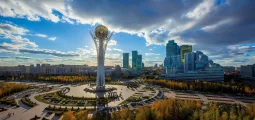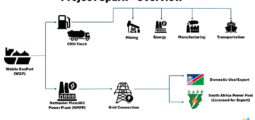China’s Silver Bullet: How ‘Silver Trains’ Could Boost the Economy
As the world’s most populous nation confronts an ageing demographic and navigates economic headwinds, including trade tensions with the US, an innovative solution is emerging: “silver trains.” These specialised rail services, tailored to the needs of senior citizens, are more than just a novel approach to tourism; they represent a strategic manoeuvre to stimulate domestic consumption and unlock the vast potential of China’s “silver economy.”

China is embarking on a journey that could redefine the relationship between transport, tourism and economic development. As the country grapples with a rapidly ageing population and seeks to counterbalance external pressures — particularly US tariffs — it is turning to an unconventional yet potentially transformative idea: “silver trains.” These are not merely upgraded carriages, but bespoke rail services designed around the needs, comfort and leisure preferences of senior citizens.
The initiative’s significance lies in its dual function: to address the demands of a growing senior demographic while stimulating domestic consumption and energising the so-called “silver economy” — the network of industries catering to older adults. This sector is expected to expand rapidly. Estimates suggest the value of China’s silver economy could reach 30 trillion yuan (about $4 trillion) by 2035, representing a substantial share of GDP.
Demographics Driving Demand
China’s demographic shift is the product of long-term trends. The one-child policy, in force from the late 1970s until its relaxation in the mid-2010s, slowed population growth but has left the country with a shrinking workforce and a fast-expanding elderly population. By the end of 2023, more than 310 million people — over 22 per cent of the population — were aged 60 or above.
This shift creates multiple pressures. Social security and healthcare systems are under strain from increased pension liabilities and rising medical costs. The smaller working-age population risks constraining economic growth, while shifting consumption patterns — with older citizens often prioritising services, healthcare and leisure over goods — will reshape demand across sectors.
Economic Headwinds
These demographic realities coincide with persistent external economic challenges. Trade tensions with the United States, which began under President Trump and have continued under President Biden, have disrupted supply chains and dampened export growth. Tariffs have made Chinese goods more expensive for US consumers, weighing on manufacturing and overseas sales.
In response, Beijing has emphasised its “dual circulation” strategy, which seeks to balance export-driven growth with a stronger domestic market. Boosting internal consumption is central to this plan, making the mobilisation of the silver economy an appealing option.
Silver Trains as Strategic Infrastructure
Against this backdrop, silver trains offer a multi-pronged solution. These services are specifically designed to remove barriers to travel for older adults, ensuring comfort, safety and enjoyment. Wide aisles, handrails, non-slip flooring and accessible restrooms allow for ease of movement. Spacious, ergonomic seating, adjustable lighting and climate control enhance the passenger experience. Some trains carry onboard medical staff, first-aid equipment and even oxygen supplies.
Service is tailored to the demographic. Attendants receive training in assisting elderly passengers with boarding, baggage handling and meal service. Routes are selected for their scenic appeal, and the journeys often incorporate entertainment — from cultural performances to activities such as karaoke or mahjong — aligning with the leisure interests of older passengers.
Economic Potential
The economic implications extend far beyond ticket sales. By encouraging domestic tourism among seniors, silver trains stimulate spending in accommodation, dining, retail and local attractions. This helps to offset the slowdown in exports and supports the government’s consumption-led growth strategy.
There is also scope for new markets in age-friendly travel packages, healthcare products and leisure services. Industries adjacent to the rail sector — including hospitality, catering, and regional transport — can benefit from a sustained influx of older tourists. Employment opportunities arise not only from operating the trains but also from the expansion of supporting industries.
The initiative also supports regional development. Routes can be designed to reach less-visited areas, spreading tourism income more evenly across the country and narrowing economic disparities between urban and rural regions. For the seniors themselves, the trains offer opportunities for social engagement, recreation and cultural enrichment, contributing to improved wellbeing.
Early Models in Operation
Several provinces have already rolled out successful examples. In Shaanxi, a Silk Road-themed train offers wide berths, temperature controls, emergency call systems, karaoke rooms and game tables, providing both comfort and entertainment. From Chengdu, services to Yunnan and Guizhou incorporate scenic journeys with on-board performances and cultural programming tailored to older passengers.
The national government is actively promoting the sector. The Ministry of Culture and Tourism, the China State Railway Group Company and other agencies have issued guidelines to retrofit existing tourist trains with elder-friendly features and to expand the network. Plans call for more than 100 high-quality railway routes for senior tourism by 2027, with thousands of trains operating annually. Tourist sites along these routes are being encouraged to improve accessibility, from streamlined ticketing to dedicated reception areas. In some cases, healthcare integration will go further, with medical professionals on board and cross-regional medical insurance settlements available during travel.
Obstacles to Overcome
While the promise is clear, the silver train concept is not without challenges. Upgrading infrastructure and training staff requires capital investment, and fares must remain affordable for seniors on fixed incomes. Accessibility is an ongoing concern, especially for passengers with disabilities or chronic illnesses, demanding rigorous adherence to universal design principles. Safety standards must be uncompromising, particularly given the greater health risks for elderly travellers.
Environmental considerations also matter. Increased rail tourism must be managed to minimise ecological impact, particularly in sensitive rural or heritage areas. There is also the broader policy challenge of balancing investment in senior-focused services with the needs of younger populations, ensuring an equitable distribution of resources.
Strategic Fit in a Changing Economy
Despite these hurdles, silver trains align closely with China’s broader strategic goals. They leverage the country’s extensive high-speed and conventional rail infrastructure, which is already among the most advanced in the world. They also dovetail with government priorities around expanding domestic consumption, reducing regional inequalities, and promoting active ageing.
By reframing an ageing population not as an economic drag but as a driver of demand, China is signalling a shift in its growth model. The silver economy represents not only a social responsibility but also an untapped commercial opportunity — and the rail sector, with its ability to deliver scale, comfort and cultural connection, is well placed to lead the charge.
Global Relevance
China’s approach may hold lessons for other countries facing similar demographic transitions. Japan has long tailored parts of its tourism industry to older travellers, while European nations have explored targeted rail discounts and accessible holiday packages. But China’s ambition — integrating customised travel services with large-scale infrastructure and economic policy — could set a new benchmark.
If successful, silver trains could become a signature feature of the country’s domestic tourism offer, boosting both economic resilience and quality of life for millions of seniors. The model could be adapted elsewhere, particularly in nations with significant rail networks and ageing populations, turning a demographic challenge into a catalyst for innovation.
Outlook
As China navigates the twin pressures of an ageing society and a shifting global economy, the silver train initiative offers a creative, pragmatic and potentially scalable solution. It is an example of policy innovation meeting market opportunity, with the potential to deliver benefits that are economic, social and cultural in equal measure.
Whether the concept can be sustained will depend on execution — from maintaining service quality to ensuring affordability and environmental sustainability. But the underlying logic is sound: by investing in the mobility, leisure and engagement of its older citizens, China is not only addressing demographic realities but also seizing an opportunity to stimulate domestic demand in a challenging economic climate.
In the years ahead, as more routes open and the silver train network expands, the initiative will serve as a test of how effectively the country can integrate demographic policy with economic strategy. Should it succeed, it will not merely be a tourism innovation, but a blueprint for harnessing the silver economy as a driver of national growth.
You may have an interest in also reading…
China’s Renminbi Needs Convertibility to Internationalise
On July 21, the Official Monetary and Financial Institutions Forum (OMFIF) published its eighth annual report on Global Public Investors
World Bank: Pandemic Recovery is an Opportunity to Step Up Climate Change Action in Europe and Central Asia
2021 needs to be the year that climate change urgency truly entered the collective consciousness and lasting action followed. In
Grant Thornton: Mobility – A Double Edged Sword?
It would be hard to imagine a chef working without a culinary knife. Different kinds of knives serve different purposes.


















































































